Last-Minute NYC Holiday Gift Guide 🎁
We’ve created a holiday gift guide with presents for the intrepid New Yorker that should arrive just in time—


The New York State Pavilion has predominantly remained dormant since it closed in the 1970s. During its heyday, however, the futuristic structure once housed state exhibits and performances, serving as the “shining star” of the 1964-65 World’s Fair, which welcomed over 51 million people, according to reports. In the decades since then, the Philip Johnson-designed Pavilion has fallen into a state of deterioration, but recent renovation efforts are aimed at restoring this iconic New York City landmark to its previous grandeur and making it accessible to visitors once again. Here are 10 secrets we uncovered about the New York State Pavilion, which consists of the “Tent of Tomorrow,” three concrete Observation Towers, and the Theaterama.

Didn't make it to the 1939/40 or 1964/65 fairs? Here's your chance!
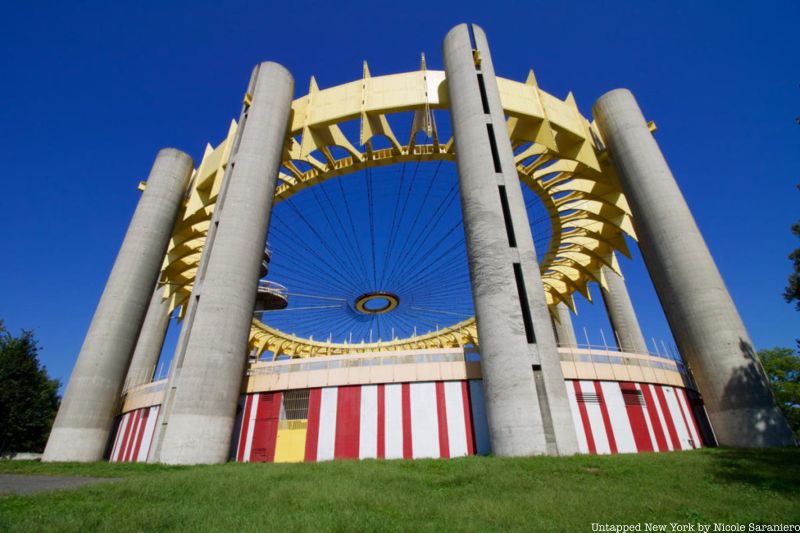
The 1964-65 World’s Fair was always meant to be a temporary affair. The same was true for the 1939-40 World’s Fair which preceded it. The iconic Trylon and Perisphere, which were the centerpieces of the fair, were both dismantled. During the installation of the 1964 fair exhibitions, all exhibitors were required to sign a lease that said that their pavilions would be demolished within 90 days of the fair’s closure in October 1965. While it was clear that most of the buildings had to go (some traveling to different states), letters uncovered by People for the Pavilion from the Rockefeller Archive Center reveal that there was extensive debate between officials over whether to save or demolish the New York State Pavilion.
One argument for its preservation was that it was “too expensive to tear down,” according to The Landmark Preservation Commission in 1995. Robert Moses foresaw a future where the Observation Towers were a great attraction. Ultimately, the structures were saved and did find alternative uses beyond the fair, at least for a short time (which you’ll discover soon!).

In 2015, The New York Structural Steel Painting Contractors’ Association spent 8,000 hours and used more than 1,600 gallons of paint to give the New York State Pavilion a new top coat. The paint job, costing more than $3 million, was part of a larger restoration effort headed by Borough President Melinda Katz, together with the de Blasio administration and the City Council.
Following a power washing session and an application of primer, the “Tent of Tomorrow” was covered with “American Cheese Yellow” paint, which was selected as the best match for the original color.
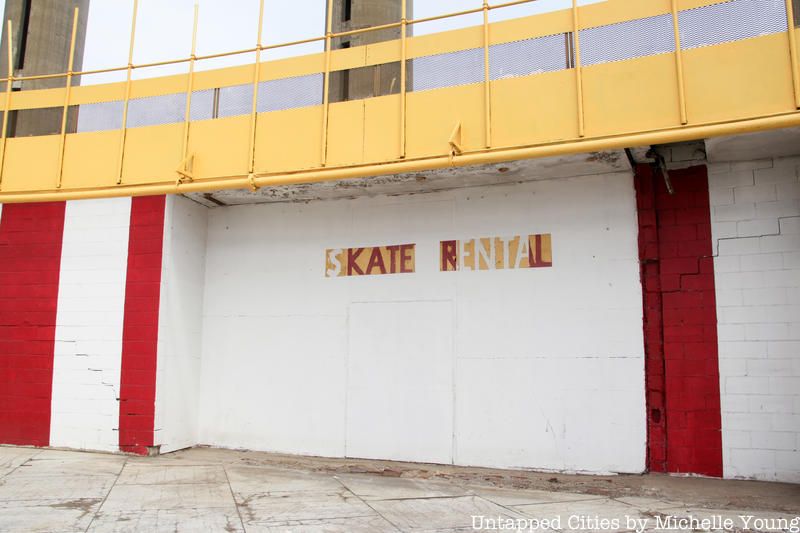
For a brief period following the 1964-65 World’s Fair, the New York State Pavilion was repurposed as an open-air concert venue: The Byrds, Fleetwood Mac, Santana, and the Grateful Dead all played shows there. (According to a forum, a Led Zeppelin concert “was wild with people climbing ropes to sneak in a $3.50 GA concert.”) From 1972 to 1974, the Pavilion temporarily housed a popular roller rink called the Roller Round. It was operated by Ohioans and newlyweds Robert Jelen and wife Christine, who had contacted the city with their proposal for what was to become Queens’ only outdoor roller skating rink. Although the idea was not well-received by all, the city needed more recreational facilities at Flushing Meadows-Corona Park, in addition to a supplementary source of revenue and someone to maintain the Pavilion. Thus, the plan for the roller rink pushed through, and the Texaco map was covered with a clear plastic coating to protect its surface from damage.
According to a 1970 article by the Long Island Post, admission was $1 with an extra 35 cents charge for skate rental. During its heyday, the rink welcomed more than 100,000 annual skaters before shuttering in 1974. At the time, a spokesman reported that the Jelens, “had not lived up to the terms of his contract which requires him to keep the building in good repair.”
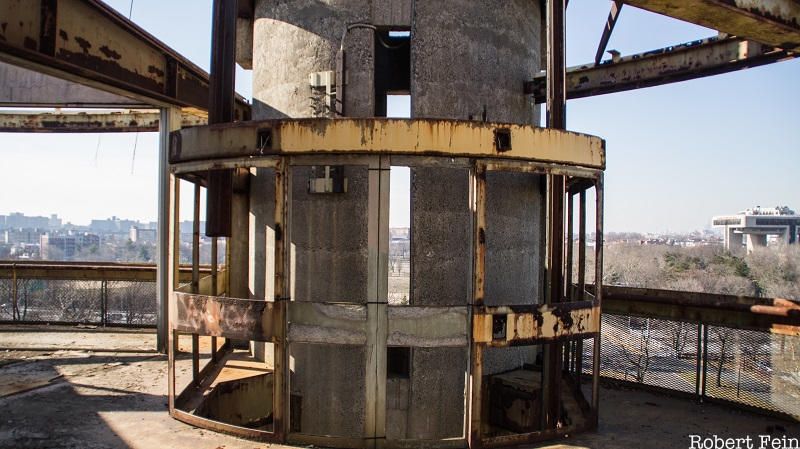
One of the highlights of the New York State Pavilion was its “Sky-Streak” capsule elevators, which zipped up and down the sides of two of the Observation Towers. Each served a specific purpose: the top tower was an observation deck; the middle sold refreshments and the lower tower was a lounge for “visiting dignitaries.”
Measuring 226 feet (or 69 meters) high, the tallest concrete tower (and the highest point of the fair) provided visitors with unobstructed overhead views of not only the fairgrounds, but New Jersey, Connecticut, the Atlantic Ocean and most of Long Island. The Sky-Streak elevators, in addition to other loose fixtures, have since been removed from the Pavilion.
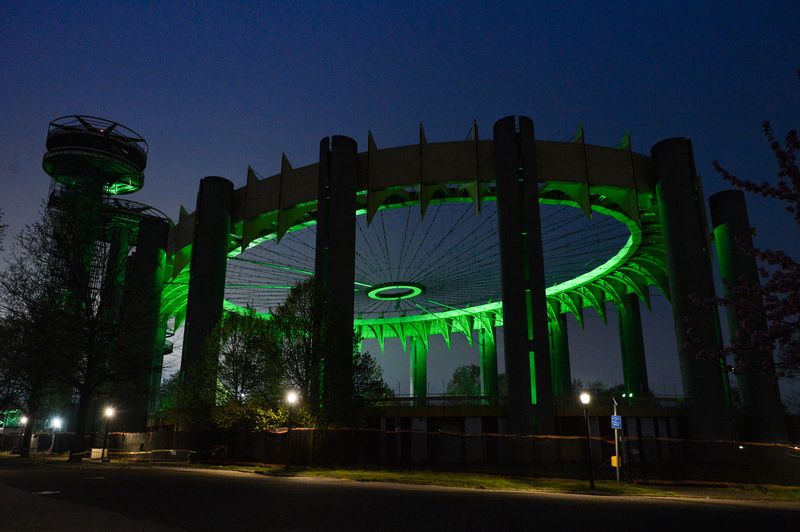
Thanks to a brand new lighting system, the New York State Pavilion will have a colorful glow every night of the week. After being tested in November of 2022, the lights went on for the first time on April 15, 2023. “Parks Green” is the color that was chosen for the inaugural display in honor of the New York City Parks Department.
The new lights are part of a $24 million restoration project which includes additional work such as stabilizing the structures, replacing deteriorated suspension cables and fixing the tower stairs, and more tasks. The pavilion will glowin different colored lights for holidays and special events.
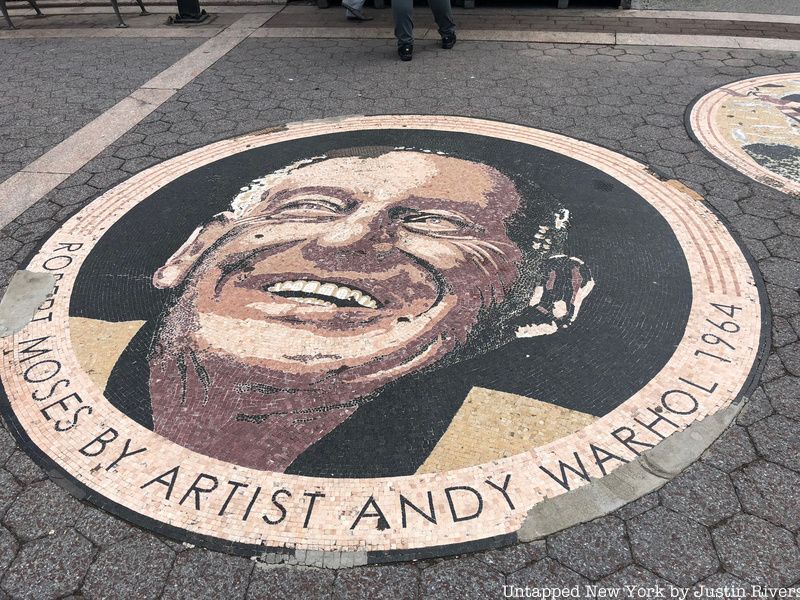
For the Fair, Philip Johnson comissioned popular artists of the time to create works that would adorn the pavilion. Among the artists chosen were Robert Indiana, Roy Lichtenstein, Andy Warhol, and others. For his piece, Warhol created a grid of enlarged silk-screened mug shots of the NYPD’s 13 most wanted criminals of 1962. Measuring 20 feet by 20 feet, the massive mural was hung on the exterior wall of the pavilion’s Theaterama building, but it was taken down before opening day.
There is no one definitive reason for why the piece was removed, but there were many contributing factors. Some reports say that then-governor Nelson Rockefeller thought the piece would offend Italian visitors to the fair, as most of the cirminals pictures were of Italian descent. Overall, officials didn’t think the expressed positive qualities of New York. To replace the most wanted men, Warhol created 25 silk-screened images of a grinning Robert Moses. Unspruirngly, this idea was also rejected.
When opening day arrived, visitors saw a large, blank, aluminum painted square that was painted over the original portraits. While Warhol went onto make other itierations of the “Most Wanted” piece, the Moses portraits have been lost. A remnant of this controversy remains however in Flushing Meadows Corona Park.
Near the Gotham Plaza Entrance to Passarelle Plaza, look down and you’ll see a mosaic of a smilling Moses attributed to Warhol. The mosaic was installed in 1998 along with a series of other round floor pieces that depict features of the fair.
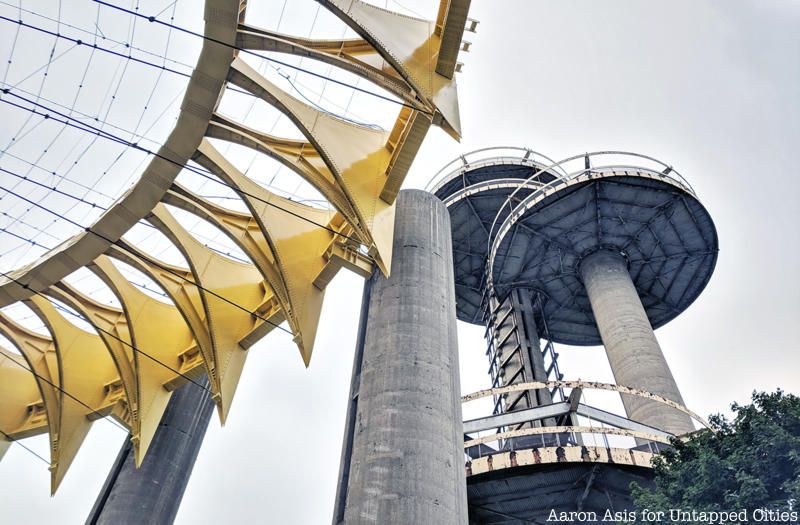
Shortly before Philip Johnson passed away, artist and photographer Phil Buehler got to speak with him about what it was like to have a building that is a ruin. In a video by Unforgotten Films from 2019, Buehler remembers that Johnson told him, “It’s neat but it’s not much of a ruin because there’s no ivy on the columns.” Buehler took it upon himself to make Johnson’s vision of a true ruin a reality.
Buehler planted ivy at the park which slowly snaked its way up the columns that ring Johnson’s Tent of Tomorrow. In the video, Buehler states that the ivy grew up to around fifty feet on four of the columns. Buehler’s photographs of the pavilion along with archival images were displayed in 2016 at the City Reliquary’s Life Of An American Ruin: Philip Johnson’s New York State Pavilion exhibit.
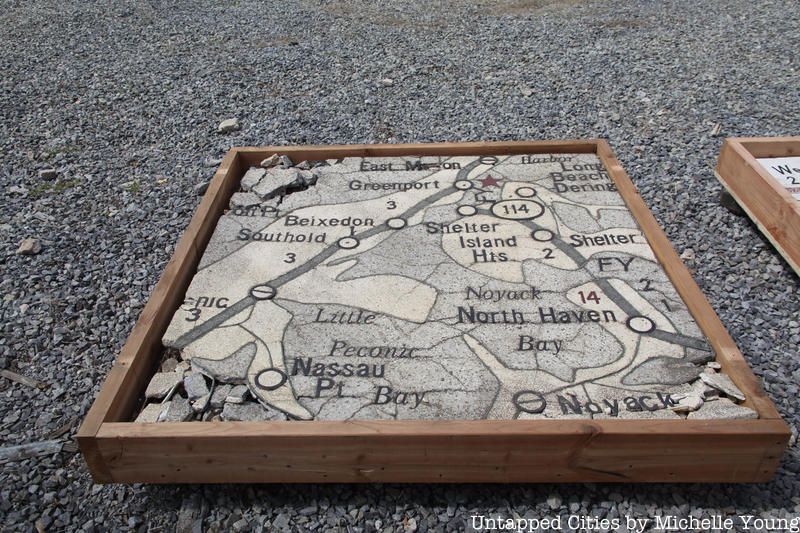
Now buried under sand, tarp, and gravel, the Texaco Terrazzo map was installed on the floor of the “Tent of Tomorrow” at the request of architect Philip Johnson. Covering 9,000 square feet and measuring 130 feet by 166 feet, the $1 million project was constructed out of 567 terrazzo mosaic panels, which each weighed 400 pounds (for a total weight of 114 tons). Only a few tiles have been preserved.
According to Rand McNally & Company, which supplied the topographic information for the map, the Texaco project was the largest known representation of any 50,000-square-mile area of the earth’s surface, featuring detailed highways, towns, cities, and the location of every Texaco gas station in the state. To produce the floor map, grid sections of a Texaco map were magnified 64 times; the scale was so large that local landmarks could have been recognized if they were placed on it. Had it not succumbed to decades of wear and tear, it would still remain the world’s largest single cartographic image to this day.
In 1970, five years after the World’s Fair, New York City considered removing the Texaco map for its reinstallation at the World Trade Center, which was under construction at the time. The map would have been incorporated into WTC’s grand courtyard, but due to objections from many groups, it remained at the Pavilion.
Six years following the Pavilion’s closure, the roof of the “Tent of Tomorrow” was declared unstable and its acrylic-colored panels were consequently removed due to safety concerns. With the Texaco map exposed to the ravages of weather, it ultimately fell into a state of severe decay before it was ultimately buried in 2009 to prevent further deterioration.
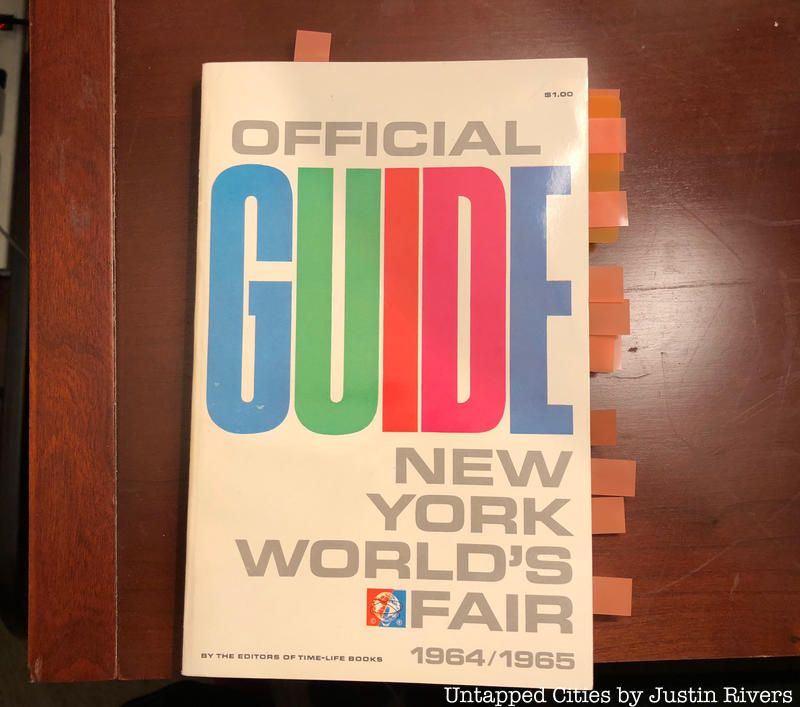
The 1965 Official Guide Book for the New York World’s Fair lists the various prices for admission into the New York State Pavilion. While access to the Tent of Tomorrow was free, adults had to pay 50 cents to visit the Observation Towers (and children, 25 cents).
When adjusted for inflation, a 50-cent admission fee costs about $3.94 today, and 25 cents is about $1.97. As an alternative to the Sky-Streak elevators, visitors could also pay $6.50 to take a helicopter tour that encircled the fairgrounds at 500 feet — that comes out to about $51.27 today (not too shabby for a helicopter ride).
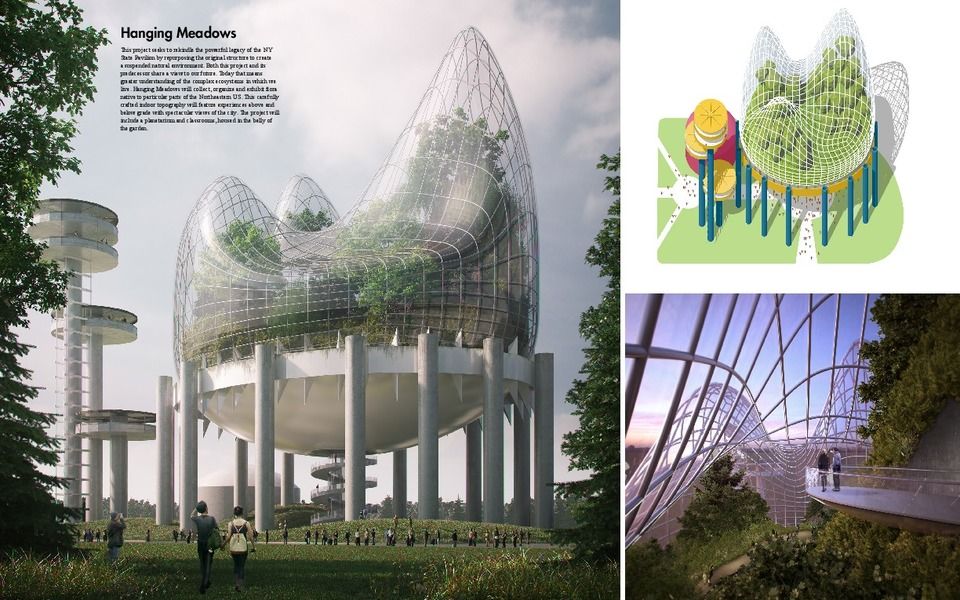
In 2016, the National Trust for Historic Preservation and People for the Pavilion announced an international visioning competition to reimagine the New York State Pavilion. The winning design, entitled “Hanging Meadows” reimagines the space as a “suspended natural environment” that would feature plants from the Northeastern United States. In addition to providing beautiful views of the city, it would serve as a planetarium and garden.
In total, over 250 design proposals were submitted. The most popular entries — although not selected — include the “Tent of the Future,” a multifunctional urban space with solar panels that capture energy, and the “Street Art Pavilion,” a “museum laboratory of urban art,” where artists and locals can meet. Check out our coverage of the competition here.

Didn't make it to the 1939/40 or 1964/65 fairs? Here's your chance!
See the structures of the New York State Pavilion on our upcoming tour of the Remants of the World’s Fairs!
This article was originally written by Susan Xu and updated by Nicole Saraniero
Next, check out our 10 Abandoned Places in Queens and the 10 Remnants of the 1964-65 World’s Fair
Subscribe to our newsletter